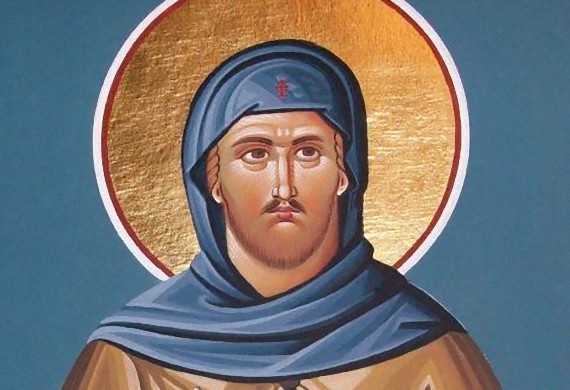Saint Cyril, whose secular name was Kyriakos, was born in Thessaloniki in
the year 1544 AD, during the reign of Sultan Suleiman. His father's name was
Peios, he came from the province of Pelagonia and resided with his family in
the vicinity of the citadel of Thessaloniki. At the age of ten, Kyriakos was left
an orphan, and as a result, two of his uncles, relatives of his mother, one of
whom was muslim took custody of him. Eventually, his muslim uncle took over
his guardianship exclusively. However, Kyriakos, following the advice of his
other uncle, who was a devout Christian, decided to secretly leave and follow
some Athonite monks, who, by good fortune, were at that time in
Thessaloniki. At the age of 14, Kyriakos arrived on Mount Athos and became
a monk in the monastery of Chelandarion, taking the monastic name Cyril.
Because he was so young, he was not allowed to stay in the monastery. So,
he practiced for eight years in an affiliated small monastic place, called
metohion. At the age of 22, he travelled with two other monks to Thessaloniki,
where he met his Christian uncle. On his way from the Acropolis area to the
port of Thessaloniki with his cousin – son of his Christian uncle – he met by
chance his muslim uncle and guardian, who, despite the years, recognized
Cyril. He immediately summoned other Muslims to arrest Cyril on the charge
that while he had previously embraced islam, but he had subsequently denied
it and left it. Cyril was immediately taken to the Turkish judge in Thessaloniki,
who attempted to persuade him to abandon the Christian faith and convert to
islam. When he found that his attempt had no effect, he ordered him to be
taken to prison, intending to pronounce his verdict the next day. The next day
Cyril was again brought before the judge, who tried a second time to dissuade
him with promises or threats, but when he found that his efforts were in vain,
he condemned him to death by fire. Cyril was led by the enraged crowd of
fanatical Turks to the place of his martyrdom, the old Byzantine Hippodrome
of the city, near the church of Saints Constantine and Helen. The Turkish
judge attempted for the last time, as was his custom, to persuade Cyril by
offering him material comforts and pleasures, but Cyril refused them, saying
that for him the only wealth was Christ. Thereupon the judge ordered to throw
Cyril into the fire, which turned his body to ashes on July 6, 1566 AD. In 1972
AD, what was left from St. Cyril, a clay vessel which contained remains of
bones and fabric mixed with ash, was found in the foundations of the old
church of Saints Constantine and Helen of Hippodrome Square at
Thessaloniki, after its demolition for the construction of the new church in its
place. The translator had the great blessing to be baptized in that old church
and spend many hours of his youth in the new church.
From the Synaxarion of Neomartyrs of the Orthodox Church
Translated by Dr. Nick Stergiou

